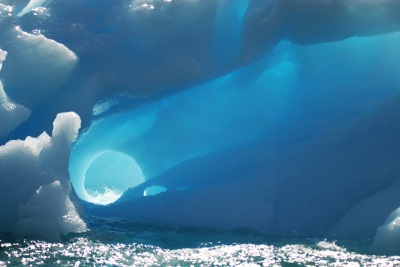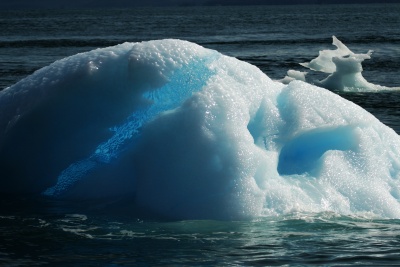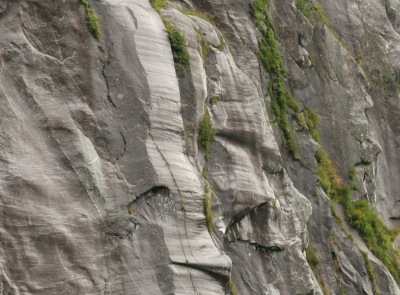Iceberg with little trapped air
Iceberg with solid ice core
Scoring marks on the walls of Tracy Arm
When snow first falls on a glacier, it's still snow, nothing special. Over a period of years the snow is covered up by newer snow, and the layers above press down on those below. Trapped gases are absorbed. At the bottom of this transition layer is nearly pure ice from which most of the gases have been absorbed. The intermediate layer, not snow but not yet pure ice, is called
firn.
Typical densities
|
Substance
|
Density
|
|
Snow
|
0.10
|
|
Firn
|
0.55
|
|
Ice
|
0.89
|
|
Pure, fresh water
|
1.00
|
Someone is bound to ask why pure ice with no trapped air doesn't have the density of water, and therefore wander freely through a surrounding body of water (rather than sit at the surface). Well, two reasons. One, there is always a bit of trapped gas, here and there. Two, because of how the atoms in ice are arranged, the overall density is less than that of water. This is why, as the temperature drops and water become ice, it paradoxically
expands. You can use water to break a very strong enclosure, by simply allowing it to freeze.
The Power of Ice
I heard a story when I was young, and now, as usual, I can't verify its accuracy. Here it is, for what it's worth. The owner of an ironworks is given a pile of cannonballs and hopes to melt them down for profit. The problem is that there is still some gunpowder left in the cannonballs, and when the melting begins, the gunpowder may explode. The man can't think of any way to break open the cannonballs without using heat.
The man's son hears the problem at the family dinner table, goes away and thinks about it. The next day, after sleeping on it, he has an inspiration: pour water into the cannonballs and let the water freeze overnight. The boy says this will split the cannonballs open. The father is dubious, but is willing to let the boy try out his idea.
About one A.M., the family is awakened by a loud cracking sound as the first of the cannonballs splits open.
Always liked that story.
The Color of Ice
Not unlike the color of the atmosphere, a pleasant blue when there is nothing but air to process the light, in icebergs the prettiest blue color emanates from the purest, oldest ice.
The atmosphere looks blue due to Rayleigh Scattering, a light-scattering process that favors shorter wavelengths like blue. This, by the way, is why the sun is an off-white when seen from the surface (in orbit, according to the astronauts, the sun appears perfectly white). The sun looks yellow when viewed through the atmosphere because the blue component of its light has been scattered through large angles.
In ice, things are a bit more complicated. In ice, blue wavelengths are those least likely to be absorbed on the way through the ice, so when one looks at a glacier or iceberg that is being illuminated by the sun, one may see a bright, rather pretty blue color on the side opposite the sun, as shown in the pictures on this page.
Tracy Arm
I visit places where one can follow the progress of icebergs, from the moment they break away from the parent glacier to the time when they are mere bits of melted ice, days or weeks later. One such place is Tracy Arm, north of Petersburg in southeast Alaska. Tracy Arm is a rather long passage with tidal glaciers at the head, so one sees various stages of iceberg melting while traveling along the passage. During the summer only a few icebergs get all the way out of Tracy Arm into Stephens Passage (but this has not always been true — years ago, all of Tracy Arm was filled with ice, and one can see scoring marks made by rocks carried along with the glacier as it made its way to open water — see picture this page).
It turns out that, when an iceberg breaks away from a glacier, it may represent a miniature version of the glacier itself, with an outer surface of snow, a layer of firn, and a solid core. As the iceberg makes its journey to the sea, the less-dense outer layers melt first, exposing more of the solid, blue core. So I can see and photograph any number of stages of iceberg evolution by traveling back and forth in a place like Tracy Arm.
Photographing Ice
I know what ice looks like in nature, and one rarely sees a picture that accurately conveys the colors. The pictures on this page are a reasonable approximation, but only because I processed the pictures after taking them, primarily by increasing their contrast. A purist may object that photographs should not be modified after the fact, and I respect this view, but I also know what ice looks like out in nature, and the pictures as taken don't accurately portray reality.
Moving a Boat Through Ice
Boaters are always getting into trouble with Alaska ice. The degree of risk seems to be positively correlated with how small, lightweight and fast a boat is, also with the inexperience of the skipper. Here are a few rules.
- All things being equal, the mass of an iceberg is equal to the cube of its height above the water. If you think about this, you will realize that the height of the iceberg is only one of three dimensions, and all three dimensions determine its mass.
- The probability of boat damage is roughly equal to the energy of a collision, and that in turn is proportional to the square of the boat's speed (because the energy of a moving object is equal to its mass times the square of its speed).
- Paradoxically, the most damaging icebergs are the "bergy bits," little, nearly solid (therefore nearly invisible), bits of ice that lie in the outer reaches of an ice area. Typically you encounter them after you have concluded there is no more ice and resume full speed.
- Never go so fast that a piece of ice will be pushed below the hull of your boat, where it can and will encounter your prop. Instead, creep along in such a way that the ice is pushed aside.
- Never enter an area of scattered ice without first considering the possibility that wind may trap you there. In the worst case, a brisk wind may push so much ice toward you that your boat will be crushed in it.
This last point is why I never make passage across the face of a glacier if there is any significant ice present. There is no place on Earth more likely to produce a sudden high wind than the face of a glacier, and you do not want to be creeping through a field of little icebergs when this happens.
A digression — why are glacier neighborhoods so unpredictably windy? The reason has to do with differences in air density. Picture a large countryside, containing areas of trees, and of ice. The forested areas get rather hot in the daylight hours, air there is less dense than over the ice, where the temperatures are lower. Every once in a while the mass of dense air over the glacier simply takes the most direct route to lower terrain — typically to where the glacier meets the water. Wind velocities there can reach hurricane force in a matter of minutes, and may end just as quickly.
Conclusion? Well, you could simply avoid the ice altogether, and any ice poses some degree of risk. But if you travel very slowly in the ice, avoid the larger icebergs, and avoid places where the wind can trap you in the ice, you can dwell there safely.
Touching the Ice
Getting onto an iceberg seems to be a fixation for many boaters. Well, don't do it. Icebergs are very unpredictable as they melt, and they can and will roll over without warning. This summer I approached a rather big iceberg to get a picture. I stopped my boat about two boat lengths away, just far enough to be safe. Then, as I prepared my camera, my wake moved out ahead of me and collided with the iceberg. My wake split this big iceberg in two, and each half rolled completely over. The waves the iceberg made were a lot bigger than my wake that triggered the split. I was lucky not to be any closer than I was.


 Share This Page
Share This Page

 Share This Page
Share This Page





 Share This Page
Share This Page